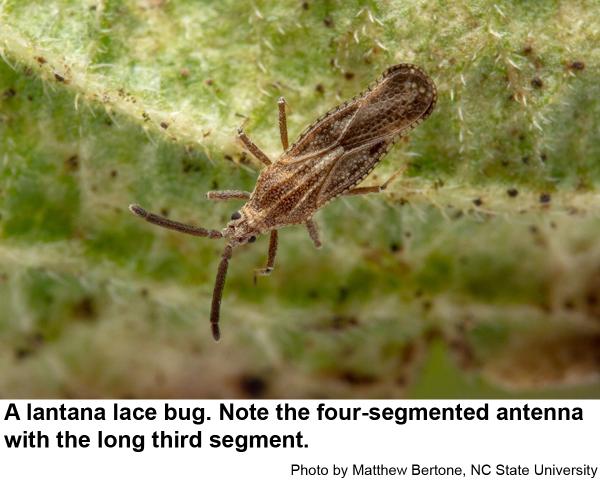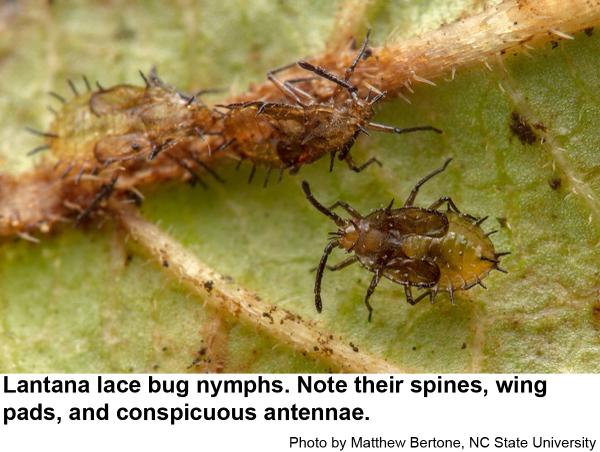Description and Biology
The lantana lace bug, Teleonemia scrupulosa, is a small (about 1/8 inch long), relatively slender, grayish-brown insect with conspicuous, dark antennae. The thorax has three ridges, and the forewings have ridges that form an "X" when at rest. This lace bug flies readily during the summer. Native to the Gulf Coast southward into South America, it occasionally reaches North Carolina. Five or six days after the last moult, females insert eggs in bunches of 10 to 30 into the undersides of leaves usually in the midrib or larger veins. About a week later, spiny nymphs hatch and begin to feed. Nymphs develop through five stages for 12 to 18 days before molting into adult bugs. At least two generations are possible here. The last two stages have noticeable wing pads. The lantana lace bug cannot overwinter successfully in North Carolina.
Host Plants
The lantana lace bug feeds primarily on lantana but occasionally infests other plants such as sesame. On Lantana, the lace bug feeds on the undersurface of the leaves and even feeds on newly opened buds and flowers. The cast skins on nymphs may remain attached to the underside a well as numerous dark spots of excrement. Pale spots appear on the top surface where the bugs feed underneath, and heavily infested leaves become almost white before dropping from the plant. On purple sage, this lace bug feeds on the upper and lower surfaces of the leaves where the dark fecal drops are conspicuous.
Residential Recommendations
Dr. Steve Frank lists several chemicals for control of lace bugs ranging from soap to pyrethroids in his insect note on lace bugs. The following are some of those available for residential landscape use. Soaps have the advantage of not leaving a toxic residue behind that might kill the tiny wasps that parasitize lace bug eggs. Imidacloprid is the active ingredient of several formulations found in garden centers. This nicotinoid has the advantage of being systemic and can be sprayed on or applied to the soil beneath infested plants. Imidacloprid is purported to cause mad bee disease, so when the lantana come into bloom, residues of imidacloprid can migrate into the flowers and contaminate the nectar. The pyrethroids bifenthrin, lamda-cyhalothrin,and permethrin are toxic to insects and fish. They persist for a long time on plants and are harsh on beneficial insects and mites, but they are available and they kill lace bugs. When used as directed, pyrethroids are very toxic to insects but are not particularly hazardous to humans and pets (other than fish—avoid using pyrethroids around pools, ponds, and streams). Two "traditional" insecticides labeled for lace bugs are the carbamate Sevin that is widely labeled for vegetables and ornamentals and the organophosphate Orthene. Orthene is systemic as well as toxic to insects on contact. It has a no-nonsense odor that warns the user and other people in the landscape not to mess with the treated plant. All of these pesticides are available the garden section of big box stores and in garden centers and nursery outlets.
Old fashioned home remedies include Ivory liquid dish washing detergent (5 tablespoons per gallon of water or about 2 teaspoons per pint).This should work as well as purchasing an insecticidal soap. As long as your dish washing detergent is not labeled as a pesticide, it is legal to use it in the landscape and interiorscape. However, if your dish washing detergent is labeled for repelling, mitigating or killing germs (or anything else), it is a pesticide that can only be used following the directions on the label.
Other Resources
- Common name: lantana lace bug, scientific name: Teleonemia scrupulosa Stål (Insecta: Hemiptera: Tingidae). D.H. Habeck, D. H., F.W. Mead, and T.R. Fasulo. 2014 (revised). Featured Creatures, Entomology & Nematology, FDACS/DPI, EDIS. Publication Number: EENY-246.
- Lace Bugs. Frank, S. 2019 (revised). Entomology Insect Notes, NC State Extension Publications.
-
The Lace Bugs (Hemiptera: Tingidae) of North Carolina and Their Hosts. Horn, K. F., C. G. Wright, and M. H. Farrier. 1979. NC Agr. Exp. Sta. Tech. Bul. 257. 22 pp.
- Extension Plant Pathology Publications and Factsheets
- Horticultural Science Publications
- North Carolina Agricultural Chemicals Manual
For assistance with a specific problem, contact your local N.C. Cooperative Extension Center.
This Factsheet has not been peer reviewed.
Publication date: Nov. 22, 2019
Reviewed/Revised: Aug. 28, 2024
Recommendations for the use of agricultural chemicals are included in this publication as a convenience to the reader. The use of brand names and any mention or listing of commercial products or services in this publication does not imply endorsement by NC State University or N.C. A&T State University nor discrimination against similar products or services not mentioned. Individuals who use agricultural chemicals are responsible for ensuring that the intended use complies with current regulations and conforms to the product label. Be sure to obtain current information about usage regulations and examine a current product label before applying any chemical. For assistance, contact your local N.C. Cooperative Extension county center.
N.C. Cooperative Extension prohibits discrimination and harassment regardless of age, color, disability, family and marital status, gender identity, national origin, political beliefs, race, religion, sex (including pregnancy), sexual orientation and veteran status.



